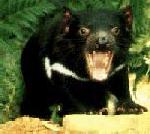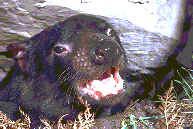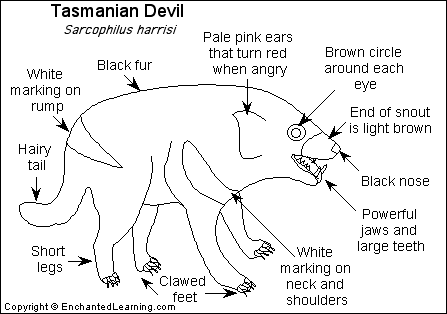|
|
| Taz Mania |
| | home |
| Games | Pictures | Hobbies | Links | Things to do | Dale Earnhardt | Chat | Greeting Cards | Classified Ads | Facts about Tasmanian Devil | Web Rings | Pokecraze | Banners | Shopping | More Shopping | Contact Us | Enjoy Horses |
| Facts about Tasmanian Devil |

Listen to a real Tasmanian Devil.
Click on play to hear.
Scientific name:
Sarcophilus harrisii
Conservation Status
Lower risk,, least concern
Tasmanian Devils are large meat-eating marsupials. Their large powerful jaws and teeth are noticeable, especially as the jaws have a gape of 120 degrees. They are black in color with white band on the chest and hindquarters and have hairless pink ears. The slightly smaller females have four teats in the backward- opening pouch. Wild tasmanian Devils often appear battle- scarred and have bald patches on their coates.
Tazmanian Devils are found in all Tasmanian habitats, including rainforests, eucalypt forests, farmlands and even outer city suburbs. Devils are not territorial, but will wander over a range of 10-20 hectares in search of food.
Tasmanian Devils are nocturnal, spending the daytime sleeping in dens make in hollow logs, caves or old wombat burrows which they line with grass and leaves.
Mating takes place between February and September and about 18 days later, up to 30 joeys are born. Each is slightly larger than a grain of rice and only between two and four are to attach to milk teats in the pouch and survive. They are carried in the pouch for about 15 weeks, after which they are left in the nest while the mother is away feeding. Later, they ride on the mother's back, or follow behind. They become independent after about 28 weeks, and may live for up to 8 years.

Threats
Found only in Tasmania, Tasmanian Devils are quite common even in suburban areas. They are often hit by cars as they feed on other road-killed animals. They were once common on mainland Australia, with remains 600 years old being found in Victoria. The arrival of the Dingo may have caused their extinction on the mainland probably because they would have competed for the same food.
By day, Devils are hidden away from danger in their burrows. If attacked, adult Tasmanian Devils can use their threatening growls and powerful bite to deter most animals. Young Devils are excellent tree climbers and it is thought that this enables them to escape predators which may include adult Devils.


